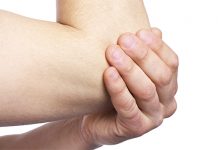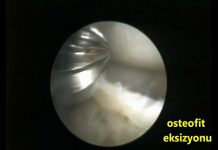ELBOW JOINT
GENERAL INFORMATION
There are different bone and soft tissue anatomies designed in accordance with the needs of the joints. The shoulder joint which has the mission of reaching the hand in 3 dimensional plane (in space) has the capability of movement to almost 360 degrees (to every direction) (figure 1). Besides, the movement limit in elbow joint is only one directional. This movement axis is called flexion/extension (opening/closing the elbow) (figure 2). The more the limit of movement a joint has, the more soft tissue support it needs for stability.
For example, providing the stability of the shoulder joint is basically the mission of the adjacent soft tissues (joint capsule, ligaments, adjacent muscles-tendons). (figure 3). However, the bone tissue is in charge with the stability of the elbow joint which does not have the movement limits as much as the shoulder. To generalise, the more a joint has the movement limits and directions, the more instability problems it will have.
If a joint movement is one directional (i.e. only opening and closing of the elbow joint) and does not have many movement limits, less instability problems are observed on that joint.
On the contrary, the limitation of movement (joint stiffness) is more commonly seen on such joints (figure 4, figure 5). In summary, in accordance with the features of each joint, either bone structure or soft tissues have more effect on the stability.
Figure 1. There are many movement limits and directions of the shoulder joint .
Figure 2. There is one movement direction of the elbow joint (opening/closing).
Figure 3. The stability of the shoulder joint is mainly provided by the surrounding soft tissues (joint capsule, ligaments, muscles-tendons).
Figure 4. The union of two bones adjacent to the elbow joint kept immobile for a long time after the fracture (radio-ulnar synostosis)
The Archive of Hakan Gündeş
Figure 5. Elbow with no direction of movement (joint stiffness)
The Archive of Hakan Gündeş
The instability of the elbow joint is rarely seen and generally starts after a significant trauma. Significant trauma can be the fractuıre of the bon structures around the joint or high energy injuries caused by the ligament or capsule rupture. If such injuries are not dult treated in time, stability problem occurs. This problem can be divided into three main groups:
1) Fractures around the elbow joint
Figure 6. Type 2 radius head fracture. Before surgical repair.
The Archive of Hakan Gündeş
Figure 7. Type 2 radius head fracture. After surgical repair.
The Archive of Hakan Gündeş
Figure 8. Olecranon fracture. Before surgical repair.
The Archive of Hakan Gündeş
Figure 42. Humerus lower end fracture. Disintegration of the bone adjacent to the joint.
The Archive of Hakan Gündeş
Figure 43. Humerus lower end fracture. 3-D tomography image.
The Archive of Hakan Gündeş
D-Distalhumerus fractures (figure 10, figure 42, figure 43, figure 44, figure 45)
Figure 10. Untreated humerus lower end fracture. There is limitation of movement of the joint as a result of misunion.
The Archive of Hakan Gündeş
Figure 9. Fracture of the coronoid bulge keeping the elbow joint together. 3-D tomography image.
The Archive of Hakan Gündeş
Figure 44. Humerus lower end fracture. After surgical repair.
The Archive of Hakan Gündeş
Figure 45. Humerus lower end fracture. During surgical repair.
The Archive of Hakan Gündeş
E-Capitellum fractures (figure 46, figure 47)
[auto_thumb width=”350″ height=”199″ link=”https://www.hakangundes.com.tr/wp-content/uploads/f1.jpg” lightbox=”true” align=”center” title=”” alt=”” iframe=”false” frame=”true” crop=”true”]https://www.hakangundes.com.tr/wp-content/uploads/f1.jpg[/auto_thumb]
2) Ligamet Injuries around the Elbow Joint
Figure 11. Chronic medial collateral ligament rupture of the elbow of a porfessional wrestler and accompaniying instability.
The Archive of Hakan Gündeş
Figure 12. Plamaris Longus tendon due to chronic injury and reconstruction.
The Archive of Hakan Gündeş
Figure 13. Medial collateral ligament injury finding of the elbow. Ecchymoses-hematoma.
The Archive of Hakan Gündeş
Figure 14. Lateral collateral ligament rupture of the elbow. Before surgical repair.
The Archive of Hakan Gündeş
C-Complete rupture of the joint capsule (Horii circle injuries)(figure 48, 49)
[auto_thumb width=”350″ height=”199″ link=”https://www.hakangundes.com.tr/wp-content/uploads/k1.jpg” lightbox=”true” align=”center” title=”” alt=”” iframe=”false” frame=”true” crop=”true”]https://www.hakangundes.com.tr/wp-content/uploads/k1.jpg[/auto_thumb]
Figure 49. The rupture of all the ligaments and the capsule around the elbow joint. Accompanying radius head fracture. Unstabile joint.
The Archive of Hakan Gündeş
Figure 48. The rupture of all the ligaments and the capsule around the elbow joint. Accompanying radius head fracture. Unstabile joint.
The Archive of Hakan Gündeş
3)Combination of Fracture and Ligament Injuries (fractured dislocations):Unhappy triad injury: Radius head, coronoid fracture and elbow dislocation (figure 30, figure 31)
[auto_thumb width=”370″ height=”199″ link=”https://www.hakangundes.com.tr/wp-content/uploads/l1.jpg” lightbox=”true” align=”center” title=”” alt=”” iframe=”false” frame=”true” crop=”true”]https://www.hakangundes.com.tr/wp-content/uploads/l1.jpg[/auto_thumb]
Figure 30. Terrible triad injury. Radius head fracture, coronoid fracture and elbow dislocation.
The Archive of Hakan Gündeş
Figure 31. Terrible triad injury.After surgical treatment.
The Archive of Hakan Gündeş
All the injuries may not be imcompatible with the above given sheme. For example, some fracture types may be observed together. As the basic principle, the fractures around the elbow joint shoukd be duly fixed by surgical methods, the ligament and soft tissue injuries should be repaired and THE JOINT MOVEMENTS AND FUNCTIONS SHOULD BE RECOVERED IMMEDIATELY.
Before perfoming these, the union can be provided by keeping the elbow joint immobile (plaster etc.). ın this case, the elbow joint is also unioned together with the fractures and LIMITATION OF ELBOW MOVEMENTS occur. In other words, the union of the fractures does not mean anything since the joint will lose its functions. Before the surgical treatment, applying early movements passing the plaster treatment will cause some other problems. Since the fracture will not be unioned and the liagements will not be healed, INSTABILITY occurs. As the patient will have pain and pathological movements with each movement of the joint, the joint will lose its functions anyway.
In summary, the two main problems of the elbow joint, INSTABILITY AND LIMITATION OF MOVEMENT are observed on the patients who are not duly treated or never apply for the treatment.
ELBOW INSTABILITIES
CONDITIONS PROVIDING THE STABILITY:
1-Joint factors:
Radius head: In a normal elbow joint, non-existence of the radius head does not effect the stability. Normal means the stability of the medial collateral ligament (MCL) of the elbow. However, the elbow joint with ruptured MCL required the existence of the radius head (figure 13). In summary, if we are not sure about the stability of the medial collateral ligament of the elbow, the best approach will be the anatomical repair of the radius head to provide the stability.
Because, in the case of stres when the MCL is ruptured, radius head will the the stabilizator.
In the LateralUlnarCollateral Ligament (LUCL) injuries, Postero-LateralRotatuarInstability (PLRI) occurs independently from the condition of the radius head (figure 14).This describes a kind of instability. Thusi the best approach will be the repair of the ligament.
Figure 14. If the MCL is injured, radius head provides the stability.
Figure 15. The critic olecranon level to keep the elbow stabile is determined as at least 50%.
[auto_thumb width=”370″ height=”199″ link=”https://www.hakangundes.com.tr/wp-content/uploads/m1.jpg” lightbox=”true” align=”center” title=”” alt=”” iframe=”false” frame=”true” crop=”true”]https://www.hakangundes.com.tr/wp-content/uploads/m1.jpg[/auto_thumb]
Radius head is the secondary important stabilizator (figure 14).
Olecranon: The main factor in the stability of the elbow joint is the coronoid bulge. In the studies in whihc the stability is tested with some lacerations, the critic olecranon level required to preserve the stability is determined as at least 50% (figure 15).
Coronoid: The amount of coronoid required fort he stability vary in accordance with the stability of the collateral ligaments and radius head. For a functional elbow joint, at least 50% of the coronoid should be preserved. If there is no accompanying radius head non-existence, it disturbs the stability significantly. The coronoid is the most important (critic) part to provide the stability (figure 16).
[auto_thumb width=”370″ height=”199″ link=”https://www.hakangundes.com.tr/wp-content/uploads/n1.jpg” lightbox=”true” align=”center” title=”” alt=”” iframe=”false” frame=”true” crop=”true”]https://www.hakangundes.com.tr/wp-content/uploads/n1.jpg[/auto_thumb]
Figure 16. Stability is mainly provided by the small bone called coronoid.
2-Ligament and soft tissue factors:
The experimental studies have shown that the stability is contributed at 50% by the collateral ligament and 50% by the joint surfaces when varus/valgus stres is applied.











